While Climate Change is being debated in Washington, practical agencies are planning for its reality here in Minnesota.
The MN Department of Health has developed a Climate and Health Program as part of a nation-wide effort to anticipate, prepare for and respond to health impacts from climate change. With funding help from Centers of Disease Control and Prevention, they have developed a video along with other resources to train and educate communities and health care professionals on the health risks of climate change.
As most of us know, climate change is the effect of a rise in greenhouse gases from the burning of fossil fuels such as coal and oil. As the levels of these greenhouse gases rise, they trap more and more heat in our atmosphere causing a greenhouse effect to our planet. Over time, our earth will continue to heat up as we continue to burn fossil fuels.
While everyone has heard of climate change and some of its effects, surprisingly few people take it seriously. Seriously enough anyway to take action or drive a political vote. The reason for this could be that, as according to a recent Yale study, 32% of Minnesotans believe climate change will impact them personally. Most believe the impacts will be on future generations, other countries, or at least not their communities.
This study shows the importance of communicating and educating on climate change, as indeed it has already begun to impact Minnesota and all of our communities. Over the next decades its effects will be not only impossible to ignore, but utterly crucial to prepare for.
Source: Howe et al., 2015
The material and presentation on the Climate and Health Program website explaining the impacts and what we can do to mitigate and adapt is not only thorough, but easy to read, including charts and graphs that make the current and future impacts of climate change both real and understandable.
After watching the video and browsing the material, here are findings I found to be important and interesting.
My first question, and the question on most Minnesotans mind about climate change is:
How has climate change already impacted Minnesota? In the last 120 years, since temperatures were recorded, MN temperatures have risen. In the first 60 years of this time period, from 1895-1960 they rose an average of .2 degrees F. In the later 60 years from 1961-2016 temps rose an average of .5 degrees F. Expectations are an average temperature increase of 5 percent F by the end of the century. It is also worth noting that over this timeframe 9 of the 10 warmest years occurred in the decade. We also know that winter and night temps are rising faster than summer and day temps. The northern part of the state is also warming faster than the southern part. 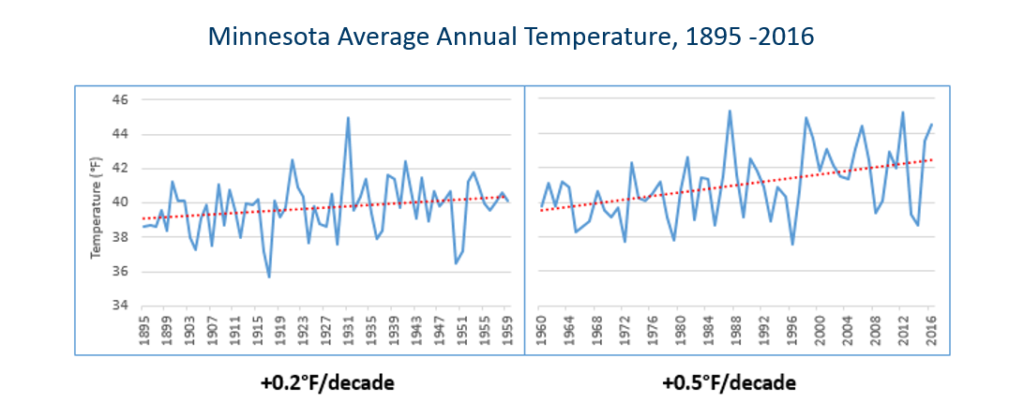
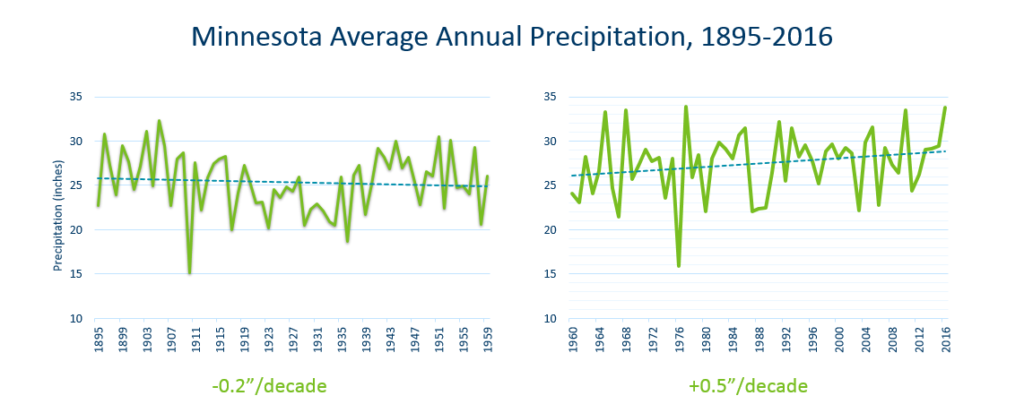
source: NOAA, 2017
Even the hardiest of us Minnesotans might be tempted to shrug and think mild winters might not be so bad after all. And that might be true if warmer winters and an overall warmer Minnesota only meant more time at the lakes and not having to haul out the Antarctic cold resistance gear once a year. Unfortunately, that is not the case. The temperatures in Minnesota not only add gumption to the residents, but define our landscape, wildlife and economics. Examples of this are the ice freeze in our lakes, bird migration, insect behavior, growing season, how we spend our time and how we spend and earn our money.
To put this in perspective, we can look at the change in plant hardiness zones within Minnesota. These zones define the type of crops that can be grown in a region. In 1990, MN was mostly zone 3 in the north and zone 4 in the south. In 2015, MN was mostly zone 4, with a small northern section remaining zone 3 and zone 5 creeping up in the south. Over the next decades, we can expect MN to become part of the cotton belt as the corn belt moves further north up into Canada. This will not only effect the farmers, but the use and loss of land as we struggle to maintain our food sources in less fertile and productive soils.
Climate change will also cause changes in precipitation. In the last 120 year period, the first 60 years showed a downward trend of rain, while the last 60 showed an upward trend. The problem with that is most of this rainfall has been from mega rain events. Is the August 2017 flooding in Maple Grove coming to anyone else’s mind (along with the wet basement and bad commute to work the next day?).
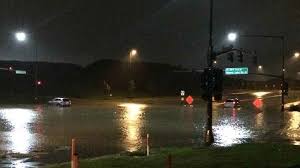
Unfortunately, this increased rainfall is not coming widespread across the state. Therefore while some areas are experiencing extreme flooding, others are experiencing extreme drought.
So our climate and weather is changing. How does this impact Minnesotans? As you might have guessed, in many different ways (and none very good). We will see effects to all of our basic needs: shelter, food, water, air quality, economics, all in turn effecting our health.
Extreme heat waves will effect the most vulnerable of the population: elderly, children and those with preexisting health conditions such as heart disease. It will also mean higher air conditioning bills and more burning of fossil fuels.

The continued burning of fossil fuels will increase pollution and decrease our air quality. With extreme weather conditions on the rise from global warming, we can expect more windy days and calm days. Calm days means stagnate air for pollutants to settle over our communities while windy days increase exposure to pollens and allergens.

The rise in temperatures will lead to longer allergy season. As a sufferer of seasonal allergies, I am feeling the pain already. And as a parent to an asthmatic child, I have great concern. The combination of more pollutants and longer and more extreme allergy seasons will cause more respiratory issues, cancer, heart disease, asthma, and bronchitis just to name a few.
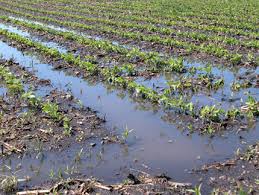
Flooding can cause contamination to our water and food supply, while drought dries it up. Other impacts from flood and drought are increased wildfires, loss of or damage to structures such as homes and cabins, and the inability to commute to work as well as increased stress for those impacted. Extreme weather conditions will also bring threats of power outages, causing further contamination to food and water among other hazards.
None of this is good for the environment, people or economics of our beloved state.
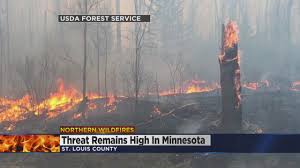
And if the news could not get bleaker, we can’t forget about our insecticide friends. Climate change will bring a significantly larger distribution of mosquito and tick populations that spread disease such as Lyme and West Nile.
And hey, there is no such thing as a free lunch, right? Right. From 1980-2019, Minnesota has been involved in 31 billion dollar events, meaning these climate related events have cost more than 1 billion dollars to clean up. As our temperatures increase, so does the paycheck and the risk to our economy to withstand it. What’s the saying, again? The best things in life are free? Well then you can bet the worst things cost a whole lot of money.
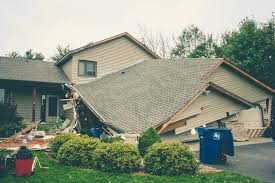
Given all of this, there is good news. The good news is that we are not helpless to this outcome. Yes, damage has been done, but further damage can be mitigated through our efforts. As individuals, we can reduce our use of fossil fuels by reducing energy use in our homes, making smart transportation choices, and reusing, recycling and reducing our everyday products. Supporting renewable energy policies, and letting your representatives know you support these policies will have a significant impact. For a more thorough list of how you can help, see our action site.
As the health institutions in our state begin to prepare for climate change, it is important that we as citizens do our part to stay educated and communicate with each other and our leaders on this issue.
To see the full presentation and more information from Department of Health click here.


